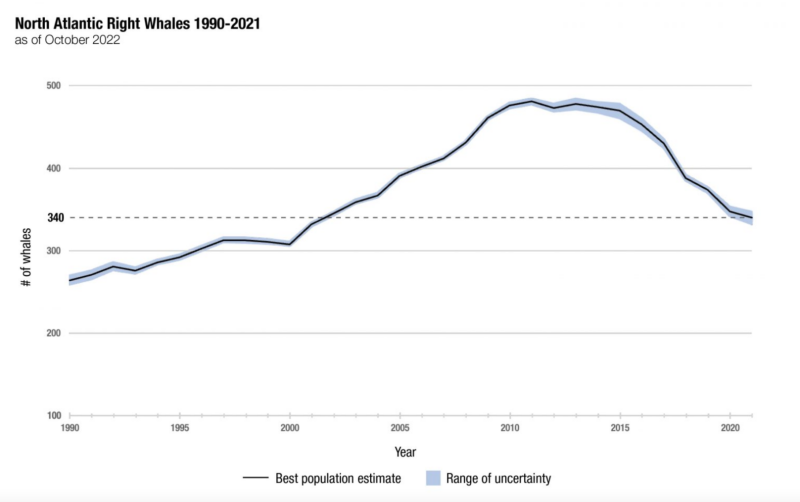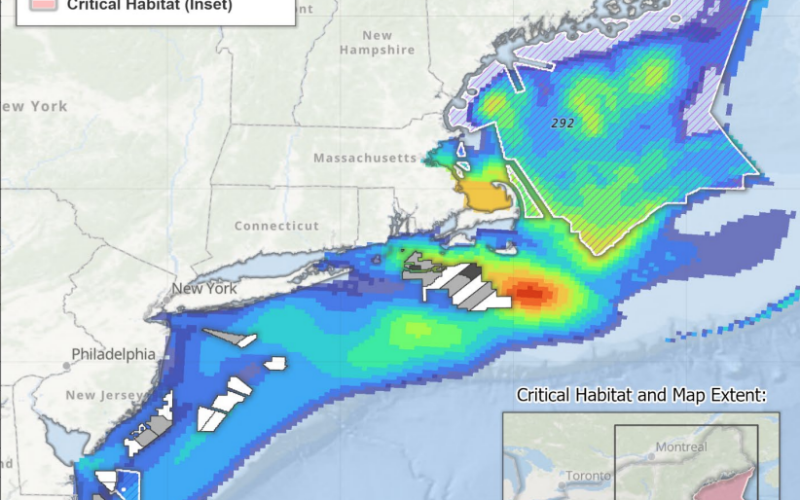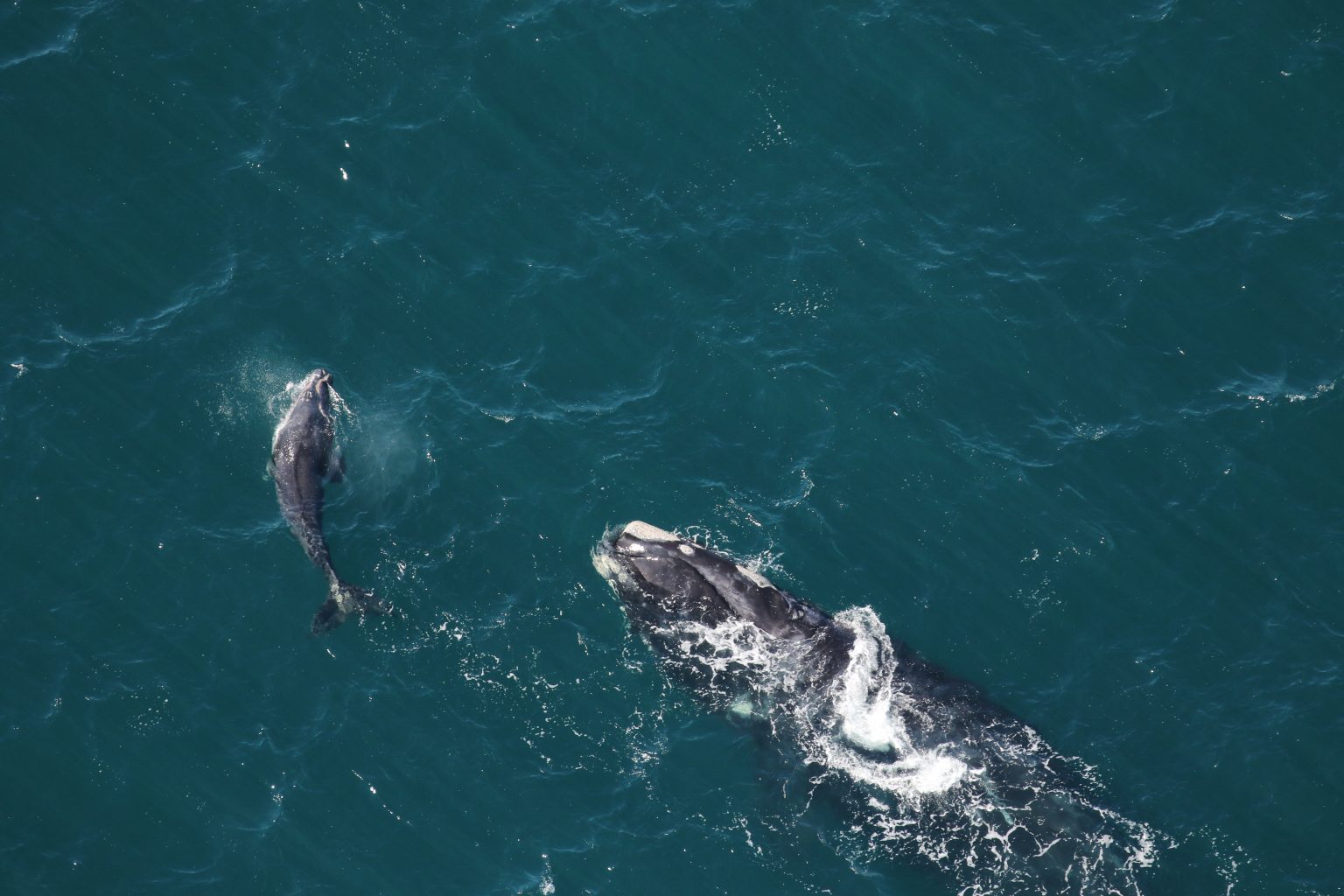Federal agencies have put out a new plan to protect the endangered North Atlantic right whales, as the government promotes aggressive development of offshore wind energy projects.
The Bureau of Ocean Energy Management and National Marine Fisheries Service released their joint strategy Oct. 21 “to protect and promote the recovery of North Atlantic right whales while responsibly developing offshore wind energy.”
The announcement initiated a 45-day public review and comment period on the draft strategy. Comments on the guidance can be submitted online via regulations.gov from October 21 to December 4, under Docket Number BOEM-2022-0066.
The plan comes out amid turmoil in the commercial fishing industry over NMFS’ new rules for gear and area restrictions in the Northeast lobster fishery to reduce the danger of entanglement with whales. The Maine Lobstermen’s Association is challenging the restrictions in federal appeals court, as NMFS looks toward potential restrictions on other East Coast fisheries that use fixed gear like fish pots and gill nets.
On Wednesday, Oct. 26 NMFS proposed the first ever “incidental take regulations” for an offshore wind project – allowing developer Ørsted and its Ocean Wind 1 project off southern New Jersey to conduct survey and construction work for wind turbines with noise and other disturbance that can affect marine mammals.
The proposed regulations would cover up to 101 wind turbine generators, three offshore substations, offshore and onshore cabling, and onshore operations and maintenance facilities associated with the project.
NMFS says it has “preliminarily determined that take from the project construction would have a negligible impact on all marine mammal species and stocks predicted to occur in the project area,” under the federal Marine Mammal Protection Act.
The proposed five-year regulations would specifically cover pile driving; blasting including potential detonation of unexploded ordnance and munitions on the sea floor; and high-resolution acoustic geophysical site assessment surveys. The rules include “extensive proposed mitigation measures to protect marine mammals,” according to NMFS.
The public comment period on the proposed regulations is open for 30 days until November 25, 2022. Documents associated with this proposed action, including information on how to submit a public comment, are available on this webpage.
Meanwhile, opponents of offshore wind projects have set their sights on the right whales’ predicament as a strategy to use for challenging wind developers and federal agencies in court. Activists and lawyers organized by the Heartland Institute, a frequent critic of renewable energy programs, say right whales could be key to a challenge of Dominion Energy’s Coastal Virginia Offshore Wind project.
In a prelude to its annual meeting this week, the North Atlantic Right Whale Consortium issued an updated assessment of the whale population numbers – all still pointing to the precarious state of the animals.
“Last year, using the best available data, the Consortium reported the 2020 population estimate to be 336 (+/-14 for range of error),” according to a summary released Monday by the group.
After processing more photos from monitoring overflights in 2020, that estimate was adjusted to 348, plus or minus five, according to the consortium. This week’s updated report will drop that estimate back down to 340 animals, plus or minus 7, in 2021.
“The current population estimate represents a continued decline for the species, showing more individual whales died than were born,” according to the report preview.
“While it is certainly good to see the slope of the trajectory slow, the unfortunate reality is that the species continues to trend downward, with fewer than 350 individuals alive in 2021,” said Heather Pettis, research scientist in the New England Aquarium’s Anderson Cabot Center for Ocean Life and executive administrator of the North Atlantic Right Whale Consortium.
In their report, the scientists express concern about the 15 calves born in 2022.
“The number is lower than the 18 born in 2021 and far below the average of 24 calves per year in the early 2000s,” the summary says. “There were also no first-time mothers in the group, which supports the findings of a new paper on breeding females showing a downward trend in the number of female right whales capable of breeding. Research has also found concerning evidence of declining body size, in part due to frequent entanglements in fishing gear, with smaller female right whales producing fewer calves.”
“With this new population estimate, the species number is now down to what it was around 2001. In the ensuing decade, the population increased by 150 whales; that tells us this species can recover if we stop injuring and killing them,” said Philip Hamilton, senior scientist at the New England Aquarium and the identification database curator for the Consortium.

The draft strategy by BOEM and NMFS lays out the agencies’ goals and objectives to better understand the effects of offshore wind development on the whales and their habitat.
“BOEM is deeply committed to ensuring responsible offshore wind energy development while protecting and promoting the recovery of the North Atlantic right whale. Working with NOAA Fisheries on this draft strategy leverages the resources and expertise of both agencies to collect and apply the best available information to inform our future decisions,” said BOEM Director Amanda Lefton. “We’re seeking open and honest feedback from the public to help us evaluate and improve this effort.”
The agencies’ document acknowledges that the loss of even one whale in a year can push the right whale population farther down the slope of decline.
NMFS declared an “unusual mortality event” after whale losses spiked in 2017, and since then it’s estimated 20 percent of the population has been affected by injuries and deaths, the plan notes.
“The actual situation is certainly much worse, with cryptic mortality (unobserved mortality)…estimated to be 64 percent of all mortality,” the plan states. “Based on this information, roughly 230 animals have died since the population peaked at 481 in 2011…Human-caused mortality is so high that no adult North Atlantic Right Whale has been confirmed to have died from natural causes in several decades; for a species that might live a century, most animals have a low probability of surviving past 40.”
Ship strikes and fishing gear entanglement are the primary human-caused mortality. Construction and operation of offshore wind turbine arrays would pose their own hazards, the plan says.
Whale researchers have documented right whales spending more time in southern New England waters in and around wind energy areas, and in 2021 called for stepping up monitoring and mitigation measures with wind development projects.

The BOEM-NMFS strategy document names four “primary stressors” that wind development can put on the whales:
- Exposure to noise and underwater pressure during construction that could result in injury, hearing impairment, or behavioral disturbance of the whales. Detonation of unexploded ordnance such as World War II naval weapons found on the Northeast seafloor could also be hazardous to the whales.
- Entanglement from cables, moorings, biological monitoring devices and fishing gear around the arrays.
- Increased risk from strikes by vessels involved in offshore wind projects construction, ongoing operations and maintenance, and potential shifting of other vessel traffic.
- Changes to habitat that may affect the abundance, quality or availability of prey, such as changes in ocean circulation and mixing in the water column due to wind currents created by the turbines and water movement around the foundations; impingement or entrainment of prey in cooling water intakes associated with High Voltage Direct Current cable systems; and the attraction of predator fish to new reef structures around the foundations, changing the fish population.
The agencies’ list of preliminary measures to minimize impact on whales focuses on reducing noise around wind projects.
Early on during the planning, site characterization and survey phases, steps will be taken to “minimize exposure of North Atlantic right whales to unavoidable noise sources,” the plan states. During construction and operation, other measures will likewise be designed to minimize overall noise footprints, and to avoid exposing whales to loud sounds during construction.
Using observers at sea and passive acoustic monitoring systems would alert developers when whales are near, and trigger mitigation measures.
“The agencies share a common goal of reducing noise generated during offshore wind construction and operation. Though many activities associated with OSW operation and construction produce noise, this strategy currently focuses on quieting pile-driving and vessel noise,” according to the agencies’ document.
“Although developers are already committing to using quieting technology, such as noise abatement systems during pile driving of turbine and substation foundations, the effectiveness of such technology can be improved by broadening the scope of quieting actions and through further technological innovation, especially with respect to lower frequency hearing specialists like North Atlantic right whales,” the document states.
BOEM now plans to develop a quieting performance standard for impact pile driving “to set a common goal for providing additional environmental protection, promoting predictability, and driving technological innovation,” according to the plan.
BOEM also wants to see “integration of vessel quieting technology in new offshore wind vessels built in the United States.”




